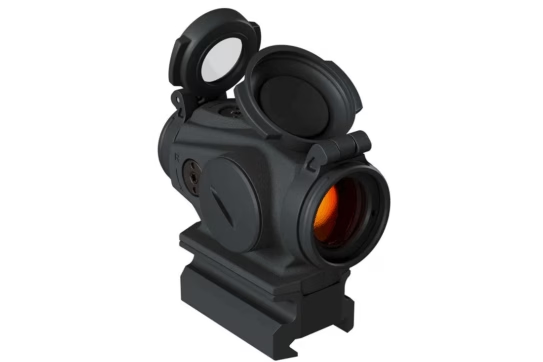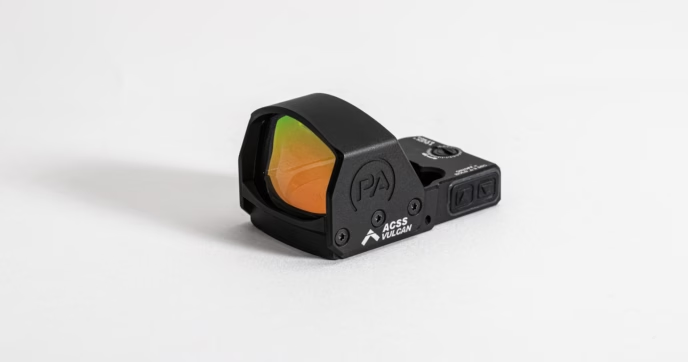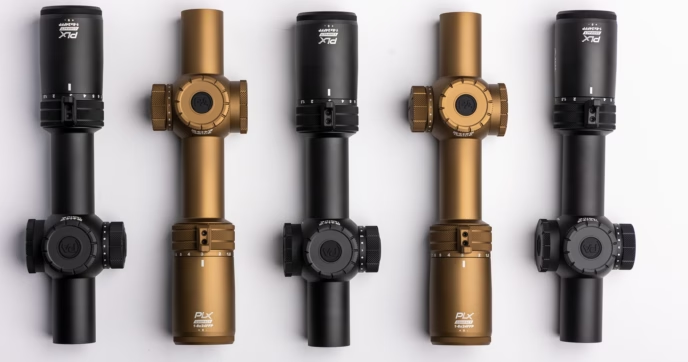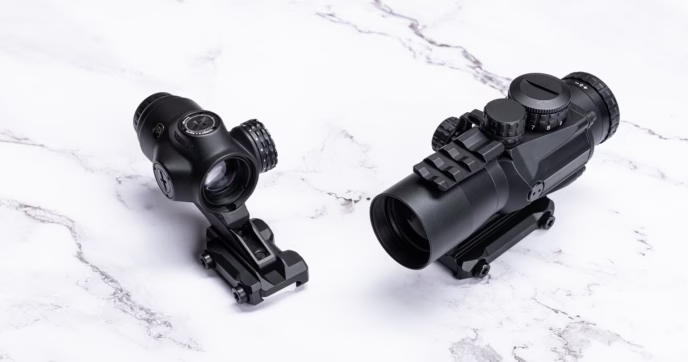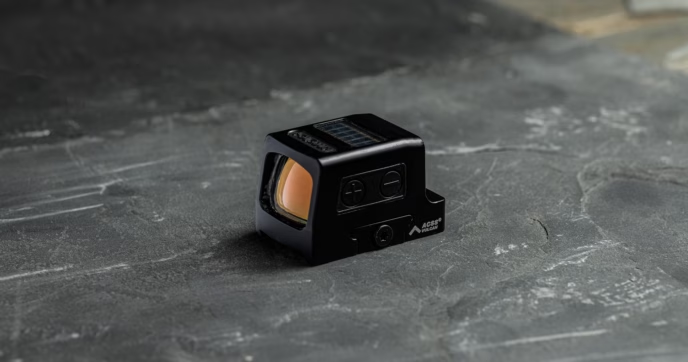Of all the purposes shotguns serve, one of their most prominent uses throughout history has been hunting. And while we’ve covered the best optics for hunting big game, and the advantages of prism scopes and night vision devices for varmint hunting, it’s high time to dominate the skies.
While shotguns are certainly a practical option for hunting large game, they’ve undoubtedly earned their keep as the greatest tool for bird hunting—so much so, that there is a plethora of top-tier shotguns designed specifically for the task. However, just like with rifles, standard iron sights have long been the norm for shotguns.
Fairly recently though, it’s become more common to see hunters running red dots on their bird guns. So, that begs the question, are red dots really an advantage when bird hunting? Follow along as we break down the different optics available on shotguns.
Understanding Shotguns
Before we get in the weeds on the various optics for shotguns, it’s critical to understand what exactly shotguns are in the first place. Compared to rifles—which we covered in Part 1 and 2—shotguns, by design, are quite different.
Shotguns are smoothbore long arms, meaning they have no rifling in their barrels, and instead of chambering brass cartridges they chamber shotshells that can hold multiple projectiles. As such, shotguns can fire multiple projectiles at once, or single projectiles called slugs.
Like rifles, shotguns are available in multiple configurations; of which, the most popular for bird hunting are semi-auto, break-action, and pump-action shotguns.
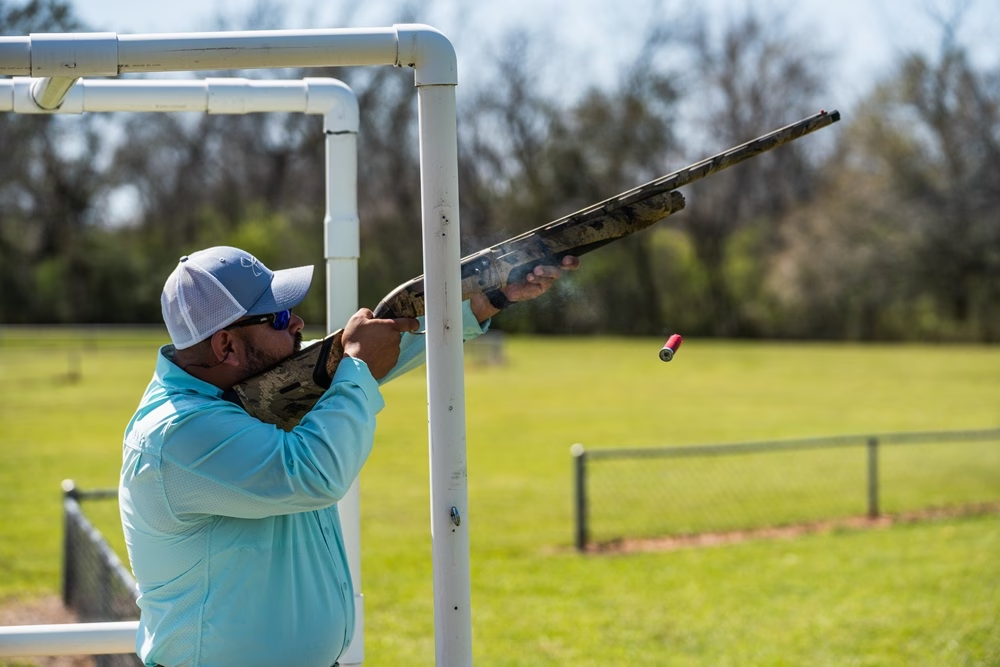
Semi-Auto Shotguns
Semi-automatic shotguns, as their name would suggest, make use of either a gas- or inertia-driven design to cycle the action after firing.
Gas-operated shotguns function similarly to gas-operated rifles, where gases created from firing a shell are siphoned from the barrel and directed back towards a piston to cycle the action. In contrast, inertia-driven shotguns rely on backpressure created from firing a shell to cycle the action, like a direct blowback PCC. Both are more-than-viable for bird hunting, but they have their pros and cons.
Gas-operated shotguns can have much softer recoil impulses than inertia-driven ones, and they’re usually less picky with ammo. However, they can be noticeably heavier due to their extra internal components, and the cleaning process can be a bit more involved. Comparatively, inertia driven shotguns are much simpler in design, and they’re fairly low-maintenance compared to gas-operated shotguns. Still, because they rely on a shell’s blowback forces to cycle the action, they can be a bit finnicky with different ammo loads, and they can have a harsher recoil impulse as well.
As far as price is concerned, it can vary. Gas-operated shotguns can cost anywhere from around $1,000 to upwards of $3,000+ depending on the model, with inertia-driven shotguns ranging anywhere from around $500 to as much as $1,500+. Regardless, both excel as dedicated bird hunting shotguns.
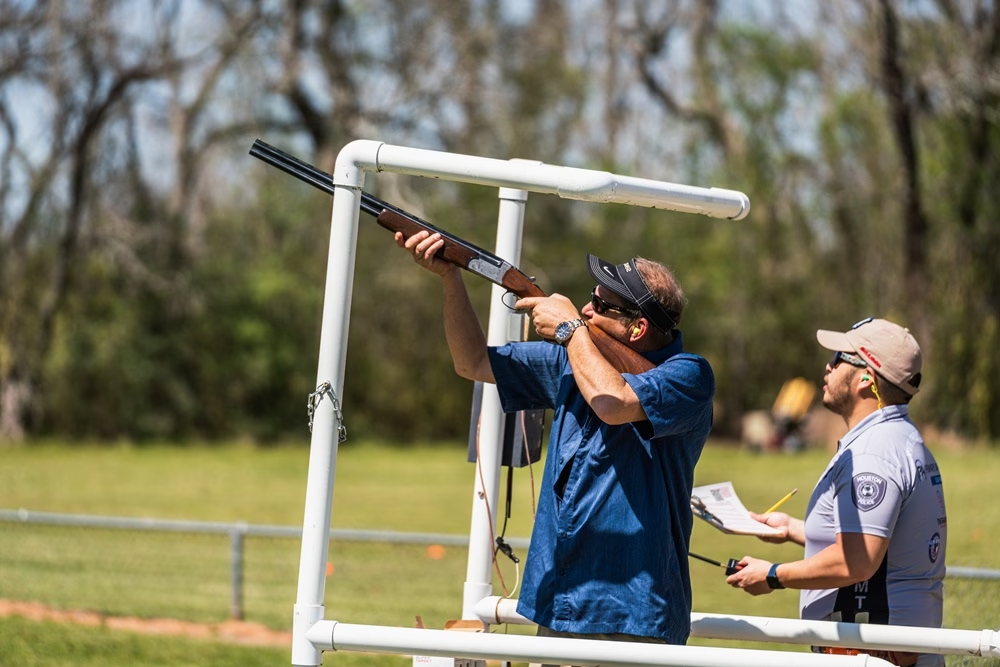
Break-Action Shotguns
For well over a century, break-action shotguns have been some of the most iconic and widely used shotguns ever created. By design, the action ‘breaks’ open at a hinge-point, allowing you to remove and reload shells. Amongst resolute bird hunters, these shotguns are often viewed as the gold standard, mainly due to their simplicity, reliability, and historical pedigree as a sporting shotgun.
Break-actions are available in many configurations, including single-shot models, double-barrel ones like the side-by-side and over-under shotguns. Of the three, over-unders are by far the most popular, especially for bird hunting. Their minimalistic and lightweight design makes them easier to quickly pull to your shoulder, pull a lead on your target, and fire. Plus, since they don’t have many moving parts, they’re exceptionally reliable. The only real downside to break-actions is their capacity, as they can only hold two shells at a time. That said, they meet most state hunting shotgun requirements, making them the go-to choice for many.
Being as popular as they are, it goes without saying that there are a lot of over-under shotguns to choose from. Budget-friendly models typically range anywhere from around $400 to upwards of $1,000+, but there are also more premium models that can range anywhere from $1,000 to as much as $3,600+, depending on the model.
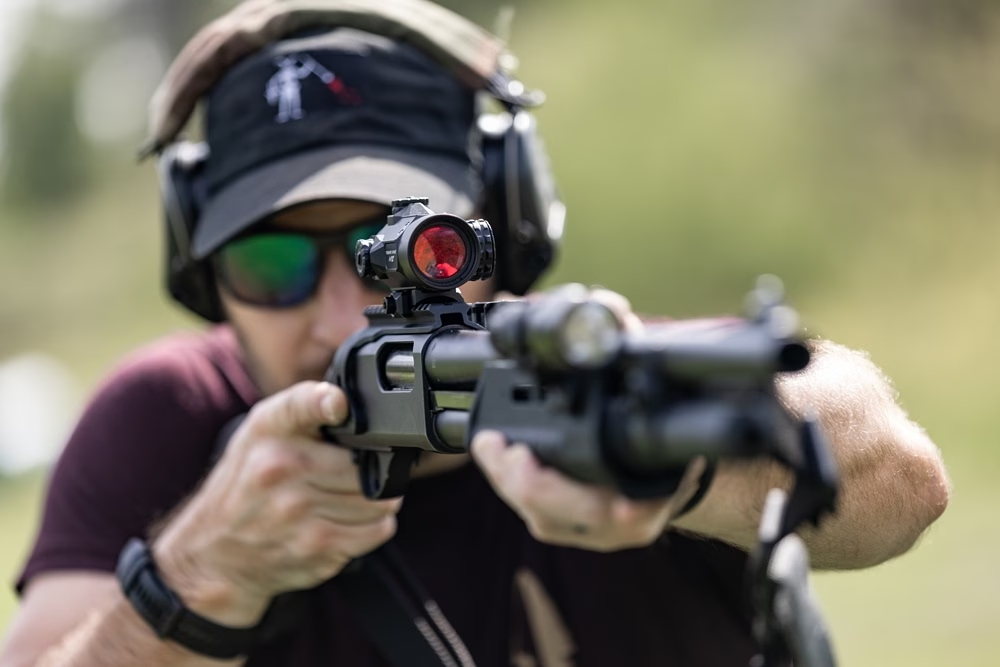
Pump-Action Shotguns
Despite not being immediately associated with bird hunting, pump-action shotguns have long been a solid possibility to consider. Arguably the most iconic shotgun design ever created, pump-action shotguns were first introduced in the late 1800s and have been in use ever since. Although they’ve primarily been used for defensive applications, they’re available in configurations that are more-than-suited for bird hunting.
Synonymous with reliability, pump-action shotguns need to be manually pumped to cycle the action, making them not only immensely resilient to harsh conditions, but also compatible with most types of shotshell loads. Plus, nowadays, they’re available in a wide range of configurations, including models with longer barrels that are more conducive for bird hunting.
As mentioned above, pump-actions aren’t typically the first option hunters usually spring for. Sure, they can be incredibly effective, but having to manually pump the action to cycle shells can shift your aim, which becomes an issue when you need to make shots in quick succession—this is a common issue with lever-action shotguns as well (but they aren’t commonly used for bird hunting). With some training though, they can still be used with little to no issues, but it’s worth keeping in mind. Lastly, you can usually find pump-action shotguns in a hunting configuration priced anywhere from as low as $220 to as much as $1,000+.
Which one is best?
You really can’t go wrong with any of the shotguns listed above, but it’s hard to beat semi-auto and break-action shotguns. Plus, with them being some of the most popular shotguns available, there’s a wide range of accessories available for them. So, regardless of which one you prefer, most, if not all, of them can be kitted out with a variety of upgraded components, and they can even support various red dot sights as well.
Before you make any final decisions though, we cannot stress the importance of checking your state and local laws regarding hunting enough. Hunting laws vary from state-to-state, so it’s critical to ensure that you check which shotguns you can legally hunt with in your area.
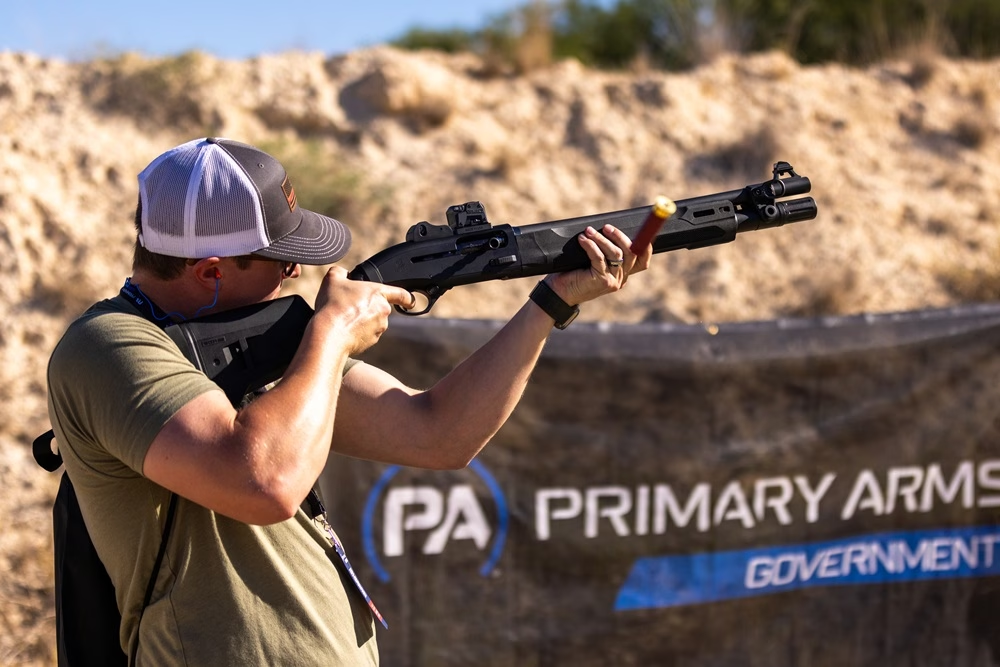
Shotgun Optics
So, now that you have an idea of the different shotguns you can use for bird hunting, we can focus on the topic that’s on everyone’s minds: optics. More specifically, reflex sights. The concept of running reflex sights on shotguns isn’t necessarily new, but it has become more common in recent years. Historically, shotguns have almost always used some form of iron sights, with the most generic form being the single bead sight—a single sight that sits at the end of the muzzle.
The Basics of Bead Sights
Bead sights have been used on shotguns for well over a century, and they’ve remained a popular choice for most applications, with bird hunting being chief amongst them. Compared to conventional iron sights, bead sights are very intuitive to use. Whereas regular iron sights consist of both a front and rear sight, bead sights have just the one sight, or bead, at the shotgun’s muzzle. They serve as more of a general point of aim rather than a true representation of where your shot will land—which makes sense considering that shotguns can fire multiple projectiles at once.
Modern Red Dot Integration on Shotguns
As we highlighted above, reflex sights have become a popular optic pairing for shotguns, and they’ve become popular amongst bird hunters because of how similar their performance is to bead sights. Like bead sights, reflex sights provide you with a wide field of view, a clear point of aim, allowing you to quickly take aim to fire. And since red dots can project multiple reticles, they have some added utility, depending on the model you opt for.
The standard 2-MOA dot reticle that most optics come equipped with is a great reticle for quickly pulling leads on targets, but more advanced reticles like circle-dot and open-circle reticles can be used to more effectively lead your target while also approximating the general spread of your shot pattern. Although shotgun pattern placement depends heavily on the type of choke and shot you use, the 65-MOA outer circles found on these reticles can be effective in most instances.
Should you Use Bead Sights or a Red Dot?
Ultimately, this decision comes down to your own personal preference. As you’d expect both sight options offer their own distinct pros and cons, with each one being better suited for different leading methods and bird types.
When hunting smaller birds, like dove and quail, hunters most often make use of the snap-shooting method—where they quickly raise the muzzle and fire at where you believe the bird is going to be mid-flight. While you aren’t strictly required to use this shooting method, traditional swing-through leading method are less conducive when hunting such birds, making snap-shooting more common in such applications. With this leading method, standard bead sights are your best option, as you won’t really be using them in the first place.
For larger birds and waterfowl, such as pheasants, ducks, and geese, it’s common for hunters to use a swing-through lead—where they first acquire the target, track its flight path, then swing through to lead it before firing. With this leading method, both bead sights and reflex sights will provide you with a clear aiming point, allowing you to easily line up and lead your targets. With that in mind, reflex sights come with the distinct advantage of projecting multiple reticles, which can make leading your target easier. Just keep in mind that your ability to use your red dot as a lead reference will depend on how far and how fast the bird is traveling, so your mileage may vary.
Your choice of optic plays a considerable role in dictating the effectiveness of your bird hunting capabilities. As such, it’s important to think about the way you prefer to hunt with a shotgun. If you prefer a snap-shot method of shooting, bead sights are going to be your best bet, and if you use a swing-through technique, you can reliably use either bead sights or a reflex sight. So long as you know how to sight in a shotgun, and dedicate time to train with your setup, you can effectively hunt birds with few issues, regardless of the optic you use.
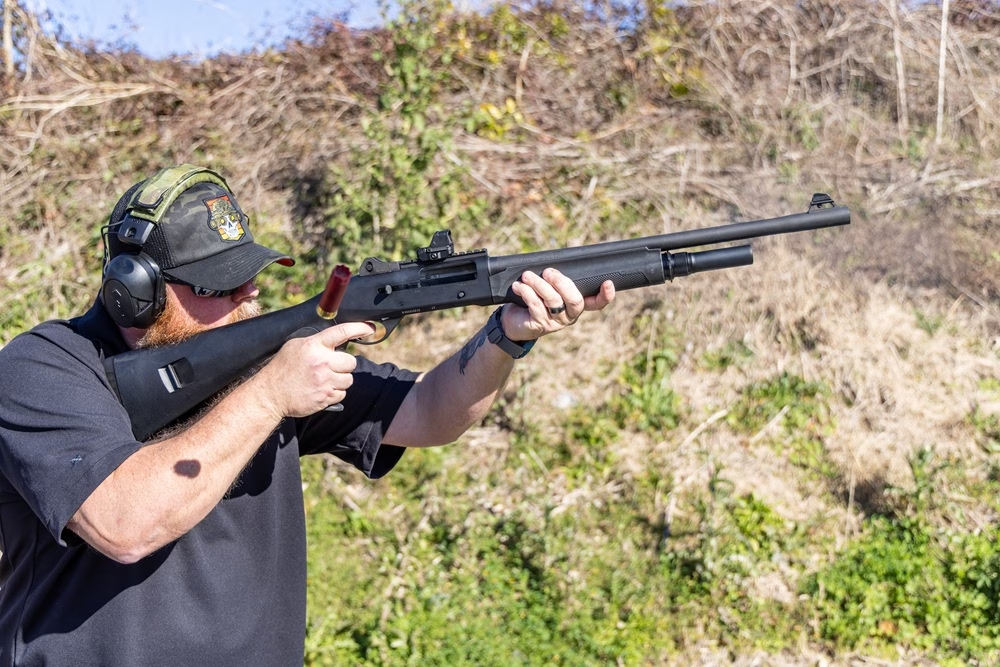
Best Red Dots for Shotguns
If you intend to use a red dot on your shotgun, it’s imperative to choose the right one for the job. Open-emitter mini-reflex sights and micro red dots are some of the best options to consider. They’re much smaller than other reflex sight variants, meaning they’re lightweight and will maintain your shotgun’s overall maneuverability. Additionally, depending on your shotgun’s mounting capabilities, there are a plethora of mounts to choose from that are compatible with such optics.
Although some shotguns come with you with threaded receivers for various optic mounts, not all do, but this doesn’t mean running an optic is impossibility. Many hunting shotguns come equipped with vent ribs that run along the barrel to vent heat and eliminate heat mirage. For these shotguns, you can opt for mounts that affix to the vent rib, giving you a secure mounting location, and the ability to mount your optic further forward, if you prefer.
Regardless, if you plan to run a red dot on your shotgun, you’ll need to know what exactly to look for. A cursory search for red dot sights will result in a whole swath of different optics, each with their own unique features. So, to make shopping for one easy, we’ve compiled a list of some of the industry’s most popular reflex sights for shotguns:
Primary Arms Optics
Widely renowned for creating utilitarian optics fit for all applications and budgets, Primary Arms Optics has become one of the leaders of the optic industry, with an extensive lineup of optics to their name. Among their vast lineup, optics like their SLx® RS-10R, GLx® RS-15, and the all-new PLx® HTX-1™ stand out as some of their top models for use on shotguns.
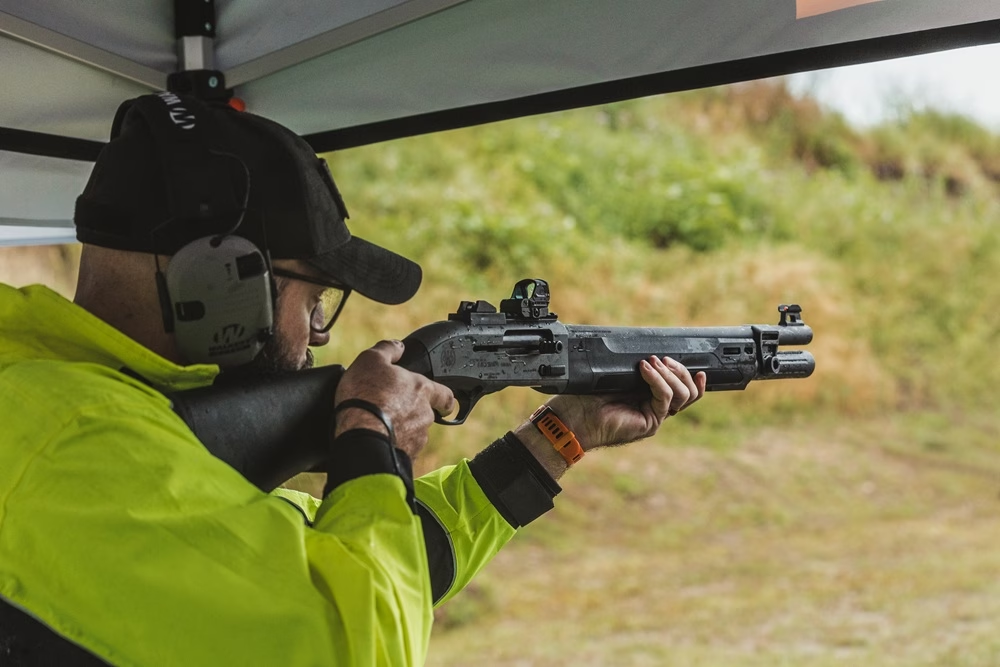
SLx RS-10 Mini Reflex Sight
The PAO SLx RS-10R mini-reflex sight is a solid optic that blends utility and affordability, effortlessly. Designed for use on handguns, it has a natural small footprint, as well as an impressively light weight of only 1.1 ounces. And this isn’t to say it’s a delicate optic either—the RS-10R is built around a rugged aluminum optic body, making it ready for just about every environment. Plus, being an open-emitter optic, it has an incredibly wide FOV, giving you a full view of your target and its surroundings.
SLx RS-10R optics have a plethora of other features too. They come standard with AutoLive® Motion-Sensing Illumination, as well as an automatic shut-off feature, so you won’t have to worry about turning off your optic after use. They also make use of a side-loading battery tray, so you won’t have to remove and re-zero your optic after putting in a new battery—not that you would have to do so often, as these optics have a 40,000-hour battery life. Lastly, the RS-10R comes standard with a 3-MOA dot reticle and makes use of the Holosun 507C mounting footprint, making it compatible with a plethora of mounts.
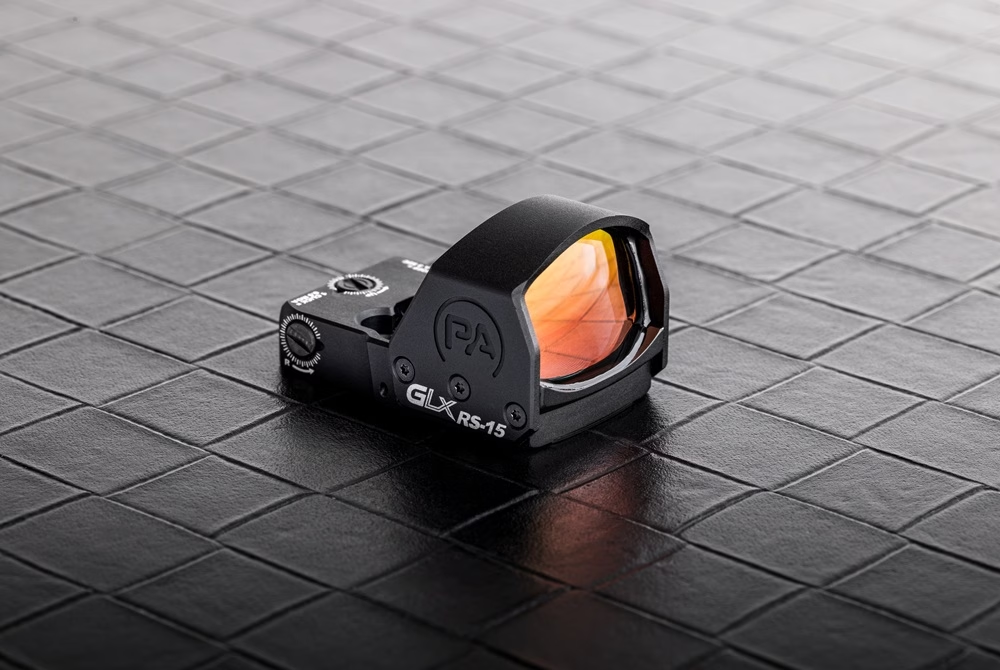
GLx RS-15 Mini-Reflex Sight
A more premium optic choice, the GLx RS-15 Mini-Reflex sight is another great pick for shotguns. Like the RS-10, these optics come equipped with AutoLive motion-sensing illumination, a timed automatic shut-off feature, is built around a solid 7075 aluminum optic body, and it doesn’t require you to remount and re-zero the optic after replacing the battery—though it does use a top-loading battery instead of a side-loading one. However, it has several features that set it apart from the RS-10.
In addition to its enhanced reticle, the RS-15 also comes equipped with fully multicoated lenses for optimal light transmission, and it’s both water and shockproof, making it ready for any environment. Lastly, it’s worth pointing out that this optic does have a shorter battery lifespan compared to the RS-10, as the GLx RS-15 Mini-Reflex Sight – ACSS Vulcan Dot Reticle has an average battery life of 25,000+ hours when using just the dot reticle. And, if you’re mindful of your brightness setting, you can extend it even further.
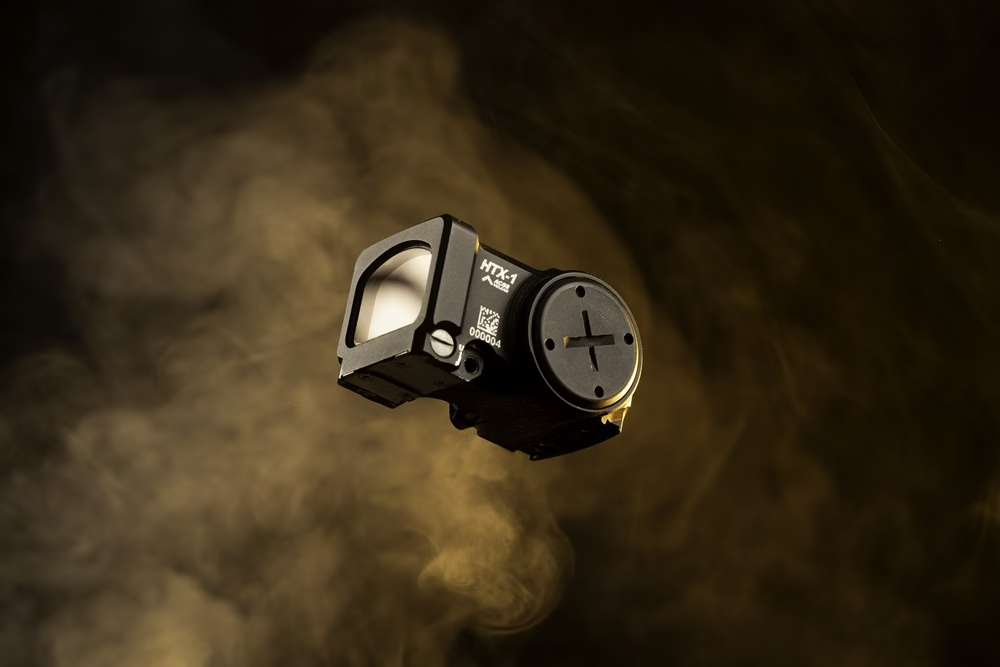
PLx HTX-1
The first American-Made red dot offered by PAO, the PLx HTX-1 is one of the most unique optics in the industry. As PAO’s first enclosed pistol red dot sight, it’s exceptionally durable, constructed around a rugged 7075-T6 aluminum optic body that’s both shockproof and waterproof, keeping the emitter diode protected from environmental hazards, always. and it comes standard with AutoLive® as well as an automatic shut-off. And for optimal use on platforms like shotguns, it’s available with a 4-MOA dot.
While it’s already an incredible optic, PAO has gone a step further to make it as utilitarian as possible. You see, rather than having its own unique optic footprint, the HTX-1 makes use of a patented modular chassis system that’s compatible with nearly every currently existing mounting footprint, making it compatible with most pistol reflex sight mounts for shotguns. Additionally, since it mounts to its own chassis instead of directly to another mount, it has a naturally low centerline, making it more-than-viable for most shotguns.
It’s worth noting that, being an enclosed optic, the HTX-1 does have a marginally narrower FOV compared to the RS-10 and RS-15. That said, it still provides a wide enough FOV to be useful for bird hunting, and it also comes with the distinct advantage of having better resistance to environmental factors like moisture thanks to its fully sealed design, making it a good choice for waterfowl hunting. Lastly, being a part of the PLx line of optics, the HTX-1 is the most expensive mini-reflex sight in PAO’s line up, with them costing around $650 or $700 depending on the model you look at.
Aimpoint
One of the most well-known optic manufacturers around, Aimpoint, is widely regarded as one of the top brands in the industry. Being the creators of the first successful commercial red dot sights, they’ve garnered immense notoriety, as well as an impressive lineup of reflex sights that are compatible with a myriad of platforms. We cover their optics in-depth in our guide on Aimpoint Red Dot & Reflex Sights, but two models that immediately stand out for use on shotguns are the Micro T-2 and ACRO P-2
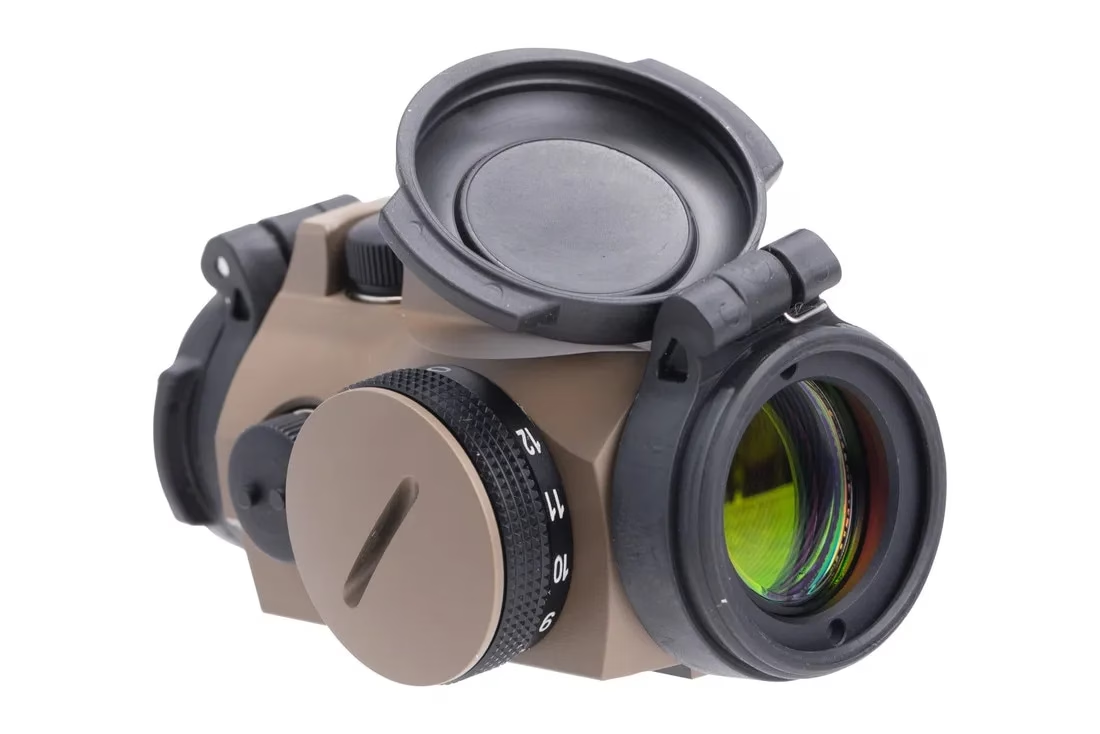
Aimpoint Micro T-2
The Aimpoint Micro T-2 Red Dot Sight is one of the most popular reflex sight models in the Aimpoint lineup. Built to withstand tough use, it has a rugged aluminum optic body that’s waterproof up to 25 meters, has been operationally tested for use in extreme temperatures, and has protected windage and elevation turrets. All of this culminates together to form an optic that’s remarkably lightweight (only 3 ounces without a mount) and exceptionally reliable, making it an ideal choice for shotguns.
Rather than using push-button controls, like many of the optics mentioned thus far, the Micro T-2 makes use of a rotary knob. This allows for quick brightness adjustments when needed, however, with such a design, it doesn’t come with any type of automatic shut-off or illumination. Still, with it being powered by a CR2032 battery, its battery life can last upwards of 50,000 hours, and if you’re mindful of your brightness setting and turn it off when it’s not being used, it’ll last for a long time.
These optics are available in many configurations, with options with different finishes and mount heights. Regardless, they all make use of a 2-MOA dot and the aptly named Aimpoint Micro mounting footprint, which most micro red dots also use. As such, there are several mounts available that are compatible with this optic.
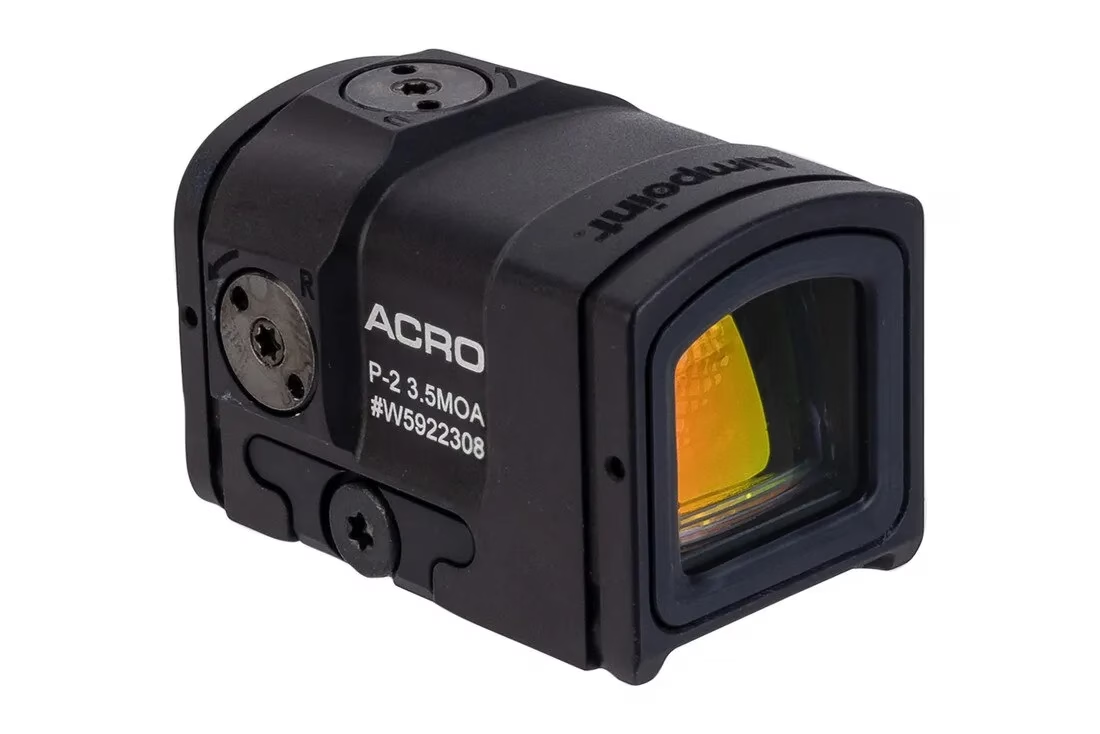
Aimpoint ACRO P-2
Another optic designed primarily for pistols, the Aimpoint ACRO P-2 is another excellent contender for those wanting a shotgun optic. Much like the Micro T-2, the ACRO P-2 is designed to meet and exceed the needs of professionals, making it field ready, regardless of the application. It’s built around an aluminum optic body, uses premium glass for its lenses, and has an exceptionally light weight of only 2.1 ounces.
As we mentioned, the ACRO P-2 is ready to withstand just about all field conditions. It’s waterproof, up to 115 feet (just over 35 meters), and it’s been extreme temperature tested. Just like the Micro T-2, it’s powered by a CR2032 battery, giving it a 50,000-hour battery life—it’s push-button controlled as well, but it doesn’t offer motion-activation or an automatic shut-off.
It’s also worth noting that the ACRO P-2 uses its own proprietary mounting footprint. That said, with it being one of the more popular pistol red dot sights on the market, there are a plethora of mounts and adapters available for it, making it compatible with most shotgun models.
Holosun
Few brands have captivated the industry quite like Holosun. For years, they’ve been crafting some of the industry’s most sought-after reflex sights, offering a vast lineup of optics that cater to every application and budget. As such, they have a plethora of high-quality optics to choose from, with one of their best options for shotguns being the HS507C.
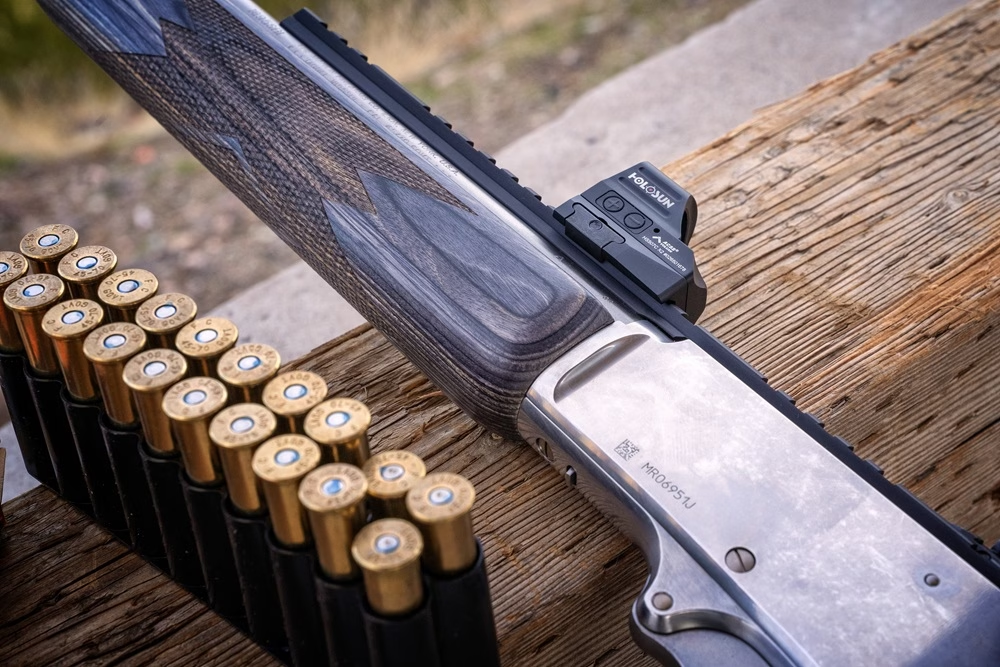
Holosun HS507C
An open-emitter mini-reflex sight, the Holosun HS507C pairs exceptionally well with shotguns, offering a wide FOV and several features that make it more-than-worth considering for hunting. For starters, the HS507C is a remarkably lightweight optic, weighing just 1.5 ounces. Plus, it makes use of the widely popular Trijicon RMR mounting footprint, making it compatible with a plethora of mounts.
Something that separates this optic from others in this list is the fact that select 507C models were designed in collaboration with Primary Arms Optics, with the Holosun HS507C-X2-ACSS being one such optic, and it makes use of a center chevron instead of a center dot.
Further enhancing this optic is it’s Shake Awake™ motion activation, as well as an automatic shut-off feature, plus it also comes standard with a built-in Solar Failsafe unit to increase its battery life when used outdoors. Lastly, it does have a shorter battery life compared to some of the other optics mentioned in this list. Still, with it being powered by a CR1632 battery and having multiple battery-life saving features, it still has a long battery life of up to 20,000 hours (over 2.25 years).
Conclusion
Shotguns remain as some of the most iconic and utilitarian long arms ever created. For over two centuries, they’ve been used for everything from personal defense to bird hunting, and with modern models continuing to push innovative mechanics and designs, they won’t be going away anytime soon.
This sense of innovation has extended to their optics as well, with reflex sights being an increasingly common pairing for shotguns, offering enhanced reticles for leading targets and wide FOVs you for a more complete sight picture. However, for bird hunting, running reflex sights is a hotly debated topic.
Ultimately, whether you go with a reflex sight or not mainly comes down to your shooting style. When hunting small, fast birds like dove and quail, hunters most often use a snap-shooting technique, doesn’t really involve aiming down your shotgun’s bead sights. Meanwhile, for larger birds, like waterfowl, where a traditional swing-through method is used, a reflex sight with a more complex reticle can substantially improve your capabilities.
Overall, while not completely necessary, red dot sights can be a game-changer for bird hunting. Still, regardless of whether you opt for a red dot or continue to use bead sights, your optic won’t matter if you don’t train with it, and one of the best ways to hone your skills for bird hunts is through skeet shooting. Our guide on the Techniques for Skeet Shooting covers everything you’ll need to know to get started.
